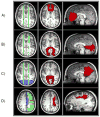Cerebral white matter integrity mediates adult age differences in cognitive performance
- PMID: 18564054
- PMCID: PMC2676336
- DOI: 10.1162/jocn.2009.21047
Cerebral white matter integrity mediates adult age differences in cognitive performance
Abstract
Previous research has established that age-related decline occurs in measures of cerebral white matter integrity, but the role of this decline in age-related cognitive changes is not clear. To conclude that white matter integrity has a mediating (causal) contribution, it is necessary to demonstrate that statistical control of the white matter-cognition relation reduces the magnitude of age-cognition relation. In this research, we tested the mediating role of white matter integrity, in the context of a task-switching paradigm involving word categorization. Participants were 20 healthy, community-dwelling older adults (60-85 years), and 20 younger adults (18-27 years). From diffusion tensor imaging tractography, we obtained fractional anisotropy (FA) as an index of white matter integrity in the genu and splenium of the corpus callosum and the superior longitudinal fasciculus (SLF). Mean FA values exhibited age-related decline consistent with a decrease in white matter integrity. From a model of reaction time distributions, we obtained independent estimates of the decisional and nondecisional (perceptual-motor) components of task performance. Age-related decline was evident in both components. Critically, age differences in task performance were mediated by FA in two regions: the central portion of the genu, and splenium-parietal fibers in the right hemisphere. This relation held only for the decisional component and was not evident in the nondecisional component. This result is the first demonstration that the integrity of specific white matter tracts is a mediator of age-related changes in cognitive performance.
Figures






Similar articles
-
Aging white matter and cognition: differential effects of regional variations in diffusion properties on memory, executive functions, and speed.Neuropsychologia. 2009 Feb;47(3):916-27. doi: 10.1016/j.neuropsychologia.2009.01.001. Epub 2009 Jan 8. Neuropsychologia. 2009. PMID: 19166865 Free PMC article.
-
Aging, cognition, and the brain: effects of age-related variation in white matter integrity on neuropsychological function.Aging Ment Health. 2019 Jul;23(7):831-839. doi: 10.1080/13607863.2018.1455804. Epub 2018 Apr 10. Aging Ment Health. 2019. PMID: 29634290
-
Quantitative fiber tracking of lateral and interhemispheric white matter systems in normal aging: relations to timed performance.Neurobiol Aging. 2010 Mar;31(3):464-81. doi: 10.1016/j.neurobiolaging.2008.04.007. Epub 2008 May 20. Neurobiol Aging. 2010. PMID: 18495300 Free PMC article.
-
Disconnected aging: cerebral white matter integrity and age-related differences in cognition.Neuroscience. 2014 Sep 12;276:187-205. doi: 10.1016/j.neuroscience.2013.11.026. Epub 2013 Nov 23. Neuroscience. 2014. PMID: 24280637 Free PMC article. Review.
-
Aging of cerebral white matter: a review of MRI findings.Int J Geriatr Psychiatry. 2009 Feb;24(2):109-17. doi: 10.1002/gps.2087. Int J Geriatr Psychiatry. 2009. PMID: 18637641 Free PMC article. Review.
Cited by
-
White matter correlates of cognitive domains in normal aging with diffusion tensor imaging.Front Neurosci. 2013 Mar 13;7:32. doi: 10.3389/fnins.2013.00032. eCollection 2013. Front Neurosci. 2013. PMID: 23493587 Free PMC article.
-
Age-related decline in the microstructural integrity of white matter in children with early- and continuously-treated PKU: a DTI study of the corpus callosum.Mol Genet Metab. 2010;99 Suppl 1(0 1):S41-6. doi: 10.1016/j.ymgme.2009.09.016. Mol Genet Metab. 2010. PMID: 20123469 Free PMC article.
-
The Influence of Feedback on Task-Switching Performance: A Drift Diffusion Modeling Account.Front Integr Neurosci. 2018 Feb 2;12:1. doi: 10.3389/fnint.2018.00001. eCollection 2018. Front Integr Neurosci. 2018. PMID: 29456494 Free PMC article.
-
Disruptions in brain networks of older fallers are associated with subsequent cognitive decline: a 12-month prospective exploratory study.PLoS One. 2014 Apr 3;9(4):e93673. doi: 10.1371/journal.pone.0093673. eCollection 2014. PLoS One. 2014. PMID: 24699668 Free PMC article.
-
Associations between white matter microstructure and amyloid burden in preclinical Alzheimer's disease: A multimodal imaging investigation.Neuroimage Clin. 2014 Feb 19;4:604-14. doi: 10.1016/j.nicl.2014.02.001. eCollection 2014. Neuroimage Clin. 2014. PMID: 24936411 Free PMC article.
References
-
- Baron RM, Kenny DA. The moderator-mediator variable distinction in social psychological research: Conceptual, strategic, and statistical considerations. Journal of Personality and Social Psychology. 1986;51:1173–1182. - PubMed
-
- Bartzokis G, Sultzer D, Lu PH, Nuechterlein KH, Mintz J, Cummings JL. Heterogeneous age-related breakdown of white matter structural integrity: Implications for cortical “disconnection” in aging and Alzheimer’s disease. Neurobiology of Aging. 2004;25:843–851. - PubMed
-
- Basser PJ, Jones DK. Diffusion-tensor MRI: Theory, experimental design and data analysis - a technical review. NMR in Biomedicine. 2002;15:456–467. - PubMed
-
- Beaulieu C. The basis of anisotropic water diffusion in the nervous system - a technical review. NMR in Biomedicine. 2002;15:435–455. - PubMed
Publication types
MeSH terms
Grants and funding
LinkOut - more resources
Full Text Sources
Medical

